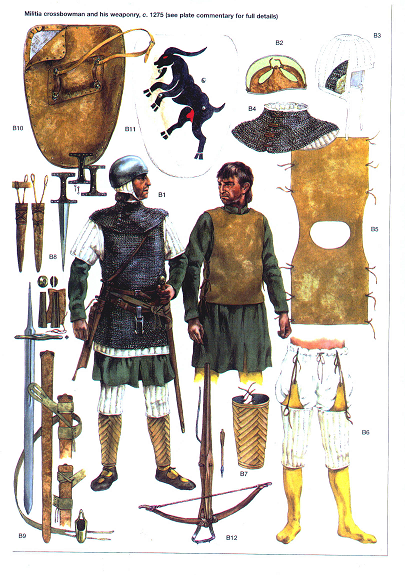Posts: 81 Location: Australia
Sun 18 Aug, 2019 8:58 pm
Not the 13th or 14th centuries, but Len Parker has discovered that the early 12th century
Gesta Herewardi contains a reference to "well cooked leather" ("coria valde coctis") being worn by men from what was probably the islands on the Scheldt River as an alternative to felt armour.
In addition to this, John of Salisbury mentions the Welsh wearing some form of "hard leather" armour (it literally translates as a breast band, but probably refers to chest protection in general), Wace refers to archers wearing either "cuiries" or gambesons in his
Roman de Rou, and Walter Map speaks of Henry II's routiers being armoured with "leather and steel".
(Read the old thread on viking leather armour from this
post on).
For the 13th century, the only references I have are Italian. There is a list of median prices for mail, leather and textile armour in 13th century Genoa in “Some industrial price movements in medieval genoa (1155–1255)”, by William N Bonds,
Explorations in Economic History, Volume 7, Issues 1–2, Autumn–Winter 1969, Pages 123-139, and Jürg Glassman's
article on the Bolognese armed societies lists leather armour as an acceptable choice for those in the Cervi armed society. Given that only the Cervi and the Vari allow leather helmets, and the Cervi has a much broader list of armour than the other societies, including more expensive options, the leather armour is probably at the low end of the scale, not the high, and the generally lower median price of leather armour in Genoa adds to this theory.
Regarding leather armour worn by men-at-arms specifically, the
Chronique des ducs de Normandie mentions Norman knights wearing it as reinforcement for their mail, as does william the Breton in his
Philippidos (Book 11, lines 126-7). Mart Shearer has
also found a reference to leather and linen armour worn in addition to mail by knights in a late 12th century English source. It's also possible that the ""paires de cuiraces"" belonging to Eudes, Comte de Nevers, were of hardened leather.
This effigy of the late 13th century could be how Eudes' armour looked, as we have no evidence of any coat-of-plates fastening in this manner and what we can see of the breastplate appears to be solid, without rivets.
